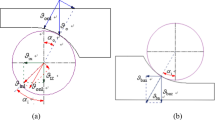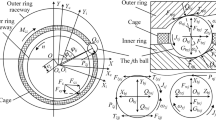Abstract
Position and velocity vectors between ball-rings, ball-cage, and cage-ring in space were considered to refine the friction heat generation rate model of ball bearings. The relationship between the position vectors of each part of a bearing in space was analyzed to determine the bearing’s status of contact bearing. Hertz contact theory and Coulomb friction law were employed to calculate the normal and friction forces at the contact points, respectively. The relationship between the velocity vectors of each part in space was analyzed, and the relative sliding velocity between two parts in contact was obtained. Friction heat generation rate of bearings was calculated as the product of friction force and relative velocity. Parameters such as bearing speed, axial load, radial load, and the groove curvature radius coefficient of bearing inner and outer rings were all investigated in the case of ball bearing heat generation. Theoretical calculation and experimental results indicate that the bearing friction heat generation rate is associated with the bearing rotation speed and bearing thrust load at ultra-high rotation speed, whereas the radial load has insignificant effect. Meanwhile, a suitable inner-outer groove curvature radius coefficient can significantly reduce the bearing friction heat generation rate.













































Similar content being viewed by others
Abbreviations
- O-XYZ :
-
The inertial coordinate system
- o-x a y a z a :
-
The azimuth coordinate system of ball
- o r -x r y r z r :
-
The fixed body coordinate system of ring
- o c -x c y c z c :
-
The coordinate system of cage
- o p -x p y p z p :
-
The coordinate system cage pocket
- o-x g y g z g :
-
The contact coordinate system
- α :
-
Semi-major axis of the contact area(mm)
- B c :
-
The width of the cage (mm)
- C g :
-
The guide clearance of the cage (mm)
- C D :
-
The drag coefficients
- D b :
-
Ball diameter (mm)
- D m :
-
Bearing pitch diameter (mm)
- E′ :
-
The equivalent elastic modulus
- f i :
-
Inner raceway groove curvature radius ratios
- f e :
-
Outer raceway groove curvature radius ratios
- F :
-
Friction force (N)
- g :
-
Acceleration of gravity (mm/s2)
- H :
-
Friction Heat generation rate (W)
- h :
-
The thickness of oil film between ball and cage wall (mm)
- K :
-
Stiffness coefficients
- R x :
-
Equivalent r curvature radius of x (mm)
- R y :
-
Equivalent r curvature radius of y (mm)
- R i :
-
Circular radius of inner ring channel curvature center (mm)
- R e :
-
Circular radius of outer ring channel curvature center (mm)
- R :
-
Equivalent r curvature radius (mm)
- r :
-
Position vector (mm)
- T :
-
Transformation matrix between coordinate systems
- K l :
-
Hertz contact stiffness coefficient of a finite length
- K c :
-
Contact stiffness coefficient of ball and the cage pocket
- ω :
-
Angular speed (rad/s)
- ω m :
-
Orbital angular velocity (rad/s)
- U :
-
Dimensionless velocity parameters
- u bc :
-
Relative sliding speed of the ball and the pocket wall (mm/s)
- u o :
-
The drag speed of the lubricant (mm/s)
- α:
-
Contact angle (rad)
- β :
-
Spiral angle (rad)
- δ :
-
Contact deformation (mm)
- ε :
-
Complete elliptic integral of the first kind
- Γ:
-
Complete elliptic integral of the second kind
- μ :
-
Friction coefficient
- v :
-
Relative sliding speed (mm/s)
- V :
-
Relative velocity (mm/s)
- ρ ef :
-
Lubricant density (g/cm3)
- ϑ:
-
Intersection angle (rad)
- η o :
-
Dynamic viscosity of lubricant (Pa.s)
- ξ :
-
Relative offset of the center of the cage (mm)
- I :
-
The inertial rectangular coordinate system of bearing
- r :
-
The fixed body coordinate system of the inner ring raceway
- a :
-
The azimuth coordinate system of the ball
- p :
-
The coordinate system cage pocket
- g :
-
The contact coordinate system
- i :
-
Inner ring
- e :
-
Outer ring
- b :
-
Ball
- r :
-
Ring
- c :
-
Cage
- j :
-
The jth ball
- x,y,z :
-
The ball coordinate components
References
Abele E, Altintas Y, Brecher C (2010) Machine tool spindle units. CIRP Ann 59(2):781–802. https://doi.org/10.1016/j.cirp.2010.05.002
Halme J, Andersson P (2010) Rolling contact fatigue and wear fundamentals for rolling bearing diagnostics-state of the art. Proc Inst Mech Eng J: J Eng Tribol 224(4):377–393. https://doi.org/10.1243/13506501JET6
Mayr J, Jedrzejewski J, Uhlmann E, Donmez MA, Knapp W, Härtig F, Wegener K (2012) Thermal issues in machine tools. CIRP Ann 61(2):771–791. https://doi.org/10.1016/j.cirp.2012.05.008
Wang YS, Liu Z, Zhu HF (2011) Heat generation of bearing. Key Eng Mater 962(7):480–481. https://doi.org/10.4028/www.scientific.net/KEM.480-481.962
Yan K, Dong L, Zheng J, Li B, Wang D, Sun Y (2018) Flow performance analysis of different air supply methods for high speed and low friction ball bearing. Tribol Int 121:94–107. https://doi.org/10.1016/j.triboint.2018.01.035
Mukutadze AM (2016) Coefficient of a rolling motion bearing drive. Procedia Eng 150:547–558. https://doi.org/10.1016/j.proeng.2016.07.040
Ma C, Yang J, Zhao L, Mei X, Shi H (2015) Simulation and experimental study on the thermally induced deformations of high-speed spindle system. Appl Therm Eng 86:251–268. https://doi.org/10.1016/j.applthermaleng.2015.04.064
Min X, Shuyun J, Ying C (2007) An improved thermal model for machine tool bearings. Int J Mach Tools Manuf 47(1):53–62. https://doi.org/10.1016/j.ijmachtools.2006.02.018
Chien CH, Jang JY (2008) 3-D numerical and experimental analysis of a built-in motorized high-speed spindle with helical water cooling channel. Appl Therm Eng 28(17–18):2327–2336. https://doi.org/10.1016/j.applthermaleng.2008.01.015
Cao H, Zhang X, Chen X (2017) The concept and progress of intelligent spindles: a review. Int J Mach Tools Manuf 112:21–52. https://doi.org/10.1016/j.ijmachtools.2016.10.005
Zhao J, Qi B, Song X, Jiang H, Dong P (2022) A modeling method for predicting friction torque of the preload double-nut ball screw based on thermal elastohydrodynamic lubrication. Int J Adv Manuf Technol 124(11–12):4231–4251. https://doi.org/10.1007/s00170-022-09524-2
Gupta PK (2020) Minimum energy hypothesis in quasi-static equilibrium solutions for angular contact ball bearings. Tribol Trans 63(6):1051–1066. https://doi.org/10.1080/10402004.2020.1788195
Gupta PK (2011) Current status of and future innovations in rolling bearing modeling. Tribol Trans 54(3):394–403. https://doi.org/10.1080/10402004.2010.551805
Leblanc A, Nelias D (2007) Ball motion and sliding friction in a four-contact-point ball bearing. J Tribol 129(4):801–808. https://doi.org/10.1115/1.2768079
Houpert L (2002) Ball bearing and tapered roller bearing torque: analytical, numerical and experimental results. Tribol Trans 45(3):345–353. https://doi.org/10.1080/10402000208982559
Harris TA, Barnsby RM, Kotzalas MN (2001) A method to calculate frictional effects in oil-lubricated ball bearings. Tribol Trans 44(4):704–708. https://doi.org/10.1080/10402000108982514
Rong Q, Lin T, Shao Y (2008) Finite element simulation of the motion process for deep-groove ball bearing. J Adv Manuf Syst 7(01):9–13. https://doi.org/10.1142/S0219686708001024
Poplawski JV (1972) Slip and cage forces in a high-speed roller bearing. J Tribol 94(2):143–150. https://doi.org/10.1115/1.3451660
Rumbarger JH, Filetti EG, Gubernick D1 (1973) Gas turbine engine mainshaft roller bearing-system analysis. J Tribol 95(4):401–416. https://doi.org/10.1115/1.3451843
Nelias D, Sainsot P, Flamand L (1994) Power loss of gearbox ball bearing under axial and radial loads©. Tribol Trans 37(1):83–90. https://doi.org/10.1080/10402009408983269
Takabi J, Khonsari MM (2013) Experimental testing and thermal analysis of ball bearings. Tribol Int 60:93–103. https://doi.org/10.1016/j.triboint.2012.10.009
Kim KS, Lee DW, Lee SM, Lee SJ, Hwang JH (2015) A numerical approach to determine the frictional torque and temperature of an angular contact ball bearing in a spindle system. Int J Precis Eng Manuf 16:135–142. https://doi.org/10.1007/s12541-015-0017-1
Pouly F, Changenet C, Ville F, Velex P, Damiens B (2010) Investigations on the power losses and thermal behaviour of rolling element bearings. Proc Inst Mech Eng Part J: J Eng Tribol 224(9):925–933. https://doi.org/10.1243/13506501JET695
Xu T, Xu G, Zhang Q, Hua C, Tan H, Zhang S, Luo A (2013) A preload analytical method for ball bearings utilising bearing skidding criterion. Tribol Int 67:44–50. https://doi.org/10.1016/j.triboint.2013.06.017
Jin C, Wu B, Hu Y (2012) Heat generation modeling of ball bearing based on internal load distribution. Tribol Int 45(1):8–15. https://doi.org/10.1016/j.triboint.2011.08.019
Chunjiang Z, Xiaokai Y, Qingxue H, Shidong G, Xin G (2015) Analysis on the load characteristics and coefficient of friction of angular contact ball bearing at high speed. Tribol Int 87:50–56. https://doi.org/10.1016/j.triboint.2015.02.012
Harris TA, Kotzalas MN (2006) Rolling bearing analysis-2 Volume Set. Crc Press
Yan K, Wang Y, Zhu Y, Hong J, Zhai Q (2016) Investigation on heat dissipation characteristic of ball bearing cage and inside cavity at ultra high rotation speed. Tribol Int 93:470–481. https://doi.org/10.1016/j.triboint.2015.09.030
Gorycki Ł, Adamczak S, Makieła W, Wrzochal M (2017) Investigation the influence of the curvature ratio on the frictional moment in rolling bearings. Procedia Eng 192:255–258. https://doi.org/10.1016/j.proeng.2017.06.044
Rabréau C, Kekula J, Ritou M, Sulitka M, Shim J, Le Loch S, Furet B (2018) Influence of bearing kinematics hypotheses on ball bearing heat generation. Procedia CIRP 77:622–625. https://doi.org/10.1016/j.procir.2018.08.192
https://www.skf.com/binary/21-299767/The0SKF0model0for0calculating0the0frictional0movement_tcm_12-299767.pdf. Accessed 18 June 2022
Brewe DE, Hamrock BJ, Taylor CM (1979) Effect of geometry on hydrodynamic film thickness. J Tribol 101(2):231–237. https://doi.org/10.1115/1.3453332
Chiu YP (1974) A theory of hydrodynamic friction forces in starved point contact considering cavitation. J Tribol 96(2):237–245. https://doi.org/10.1115/1.3451935
Gupta PK (1979) Dynamics of rolling-element bearings—Part I: cylindrical roller bearing analysis. J Tribol 101(3):293–30. https://doi.org/10.1115/1.3453357
Harris TA, Mindel MH (1973) Rolling element bearing dynamics. Wear 23(3):311–337. https://doi.org/10.1016/0043-1648(73)90020-3
Streeter V (1951) Fluid mechanics. McGraw-Hill, New York, pp 313–314
Funding
This work has been partly supported by the Key R&D project of Shandong Province (2019GGX104081, 2019GGX104033), National Natural Science Foundation of China (No. 51805299), Shandong Province’s Key Support Regions Introducing Urgently Needed Talent Projects, and Young Innovative Talents Introduction and Training Program Project of Shandong Provincial Department of Education, China Postdoctoral Science Foundation (2022M712393).
Author information
Authors and Affiliations
Contributions
Investigation, data curation, formal analysis, visualization, software, writing—original draft, and writing—review and editing, Jie Yu; formal analysis, and software, graphics processing, Shuailun Zhu; conceptualization, methodology, resources, supervision, and writing—review and editing, Wei Yuan; supervision, and review—editing, Qianjian Guo. All the authors have read and agreed to the published version of the manuscript.
Corresponding author
Ethics declarations
Conflict of interest
The authors declare no competing interests.
Additional information
Publisher's note
Springer Nature remains neutral with regard to jurisdictional claims in published maps and institutional affiliations.
Rights and permissions
Springer Nature or its licensor (e.g. a society or other partner) holds exclusive rights to this article under a publishing agreement with the author(s) or other rightsholder(s); author self-archiving of the accepted manuscript version of this article is solely governed by the terms of such publishing agreement and applicable law.
About this article
Cite this article
Yu, J., Zhu, S., Yuan, W. et al. Investigation on the friction heat generation rate of ball bearings at ultra-high rotation speed. Int J Adv Manuf Technol 128, 57–79 (2023). https://doi.org/10.1007/s00170-023-11649-x
Received:
Accepted:
Published:
Issue Date:
DOI: https://doi.org/10.1007/s00170-023-11649-x




